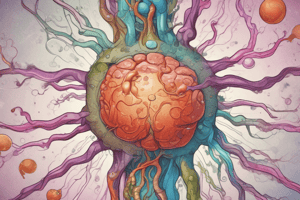Podcast
Questions and Answers
What type of immunity is acquired through recovery after an illness?
What type of immunity is acquired through recovery after an illness?
- Natural Passive Immunity
- Artificial Passive Immunity
- Natural Active Immunity (correct)
- Artificial Active Immunity
Which of the following acts as a physical barrier in the body's natural defenses?
Which of the following acts as a physical barrier in the body's natural defenses?
- Lysozyme in tears
- Inflammatory response
- Sweat gland secretions
- Cilia (correct)
Which bacterium is known for causing diseases under anaerobic conditions?
Which bacterium is known for causing diseases under anaerobic conditions?
- Escherichia coli
- Clostridium species (correct)
- Staphylococcus aureus
- Bacillus species
Which of these is a characteristic of Pseudomonas aeruginosa?
Which of these is a characteristic of Pseudomonas aeruginosa?
What is the role of endospore formation in bacteria?
What is the role of endospore formation in bacteria?
Which of the following diseases is caused by a sexually transmitted pathogen?
Which of the following diseases is caused by a sexually transmitted pathogen?
What type of immunity involves receiving antibodies through an injection?
What type of immunity involves receiving antibodies through an injection?
Which immune response is activated during the second line of defense?
Which immune response is activated during the second line of defense?
What differentiates artificial active immunity from natural active immunity?
What differentiates artificial active immunity from natural active immunity?
Which component is NOT considered part of the body's first line of defense?
Which component is NOT considered part of the body's first line of defense?
How does the inflammatory response benefit the immune system?
How does the inflammatory response benefit the immune system?
Which type of immunity is characterized by short-term protection against pathogens?
Which type of immunity is characterized by short-term protection against pathogens?
Which of the following is an example of artificial passive immunity?
Which of the following is an example of artificial passive immunity?
Flashcards are hidden until you start studying
Study Notes
Immunity and Defense Mechanisms
- Natural Immunity is developed through exposure to infections.
- Natural Active Immunity is acquired from recovery after illness.
- Example: Immunity to mumps after recovering from the illness.
- Natural Passive Immunity is short-term immunity passed from mother to child.
- This occurs through colostrum and breastfeeding.
- Natural Active Immunity is acquired from recovery after illness.
- Artificial Immunity is developed through medical intervention.
- Artificial Active Immunity is acquired through vaccinations.
- Example: Immunity to tetanus after receiving the tetanus vaccine.
- Artificial Passive Immunity is immunity received from an injection of antibodies.
- Example: Immunity to diphtheria after receiving a booster injection.
- Artificial Active Immunity is acquired through vaccinations.
- Body's Natural Defenses include physical and chemical barriers.
- Physical Barriers: Skin, cilia, and mucus prevent pathogens from entering the body.
- Chemical Barriers: Lysozyme in tears and saliva, and sweat gland secretions inhibit microbial growth.
- Inflammatory Response is characterized by redness, swelling, pain, and warmth.
- This serves to isolate and eliminate pathogens.
- Lines of Defense are categorized into three stages.
- First Line: Skin, tears, and mucus act as external barriers.
- Second Line: Inflammatory response and non-specific immune cells.
- Third Line: Specific immune responses target particular pathogens, such as the production of antibodies.
Bacterial Characteristics and Environments
- Pathogenic Bacteria cause diseases in humans.
- Pseudomonas aeruginosa is known for its blue-green pigment, pyocyanin, and is common in nosocomial infections.
- Clostridium species cause diseases under anaerobic (oxygen-free) conditions and are often found in soil and dust.
- Bacillus species are known for forming spores and are mostly found in dust, soil, and animal intestines.
- Environmental Requirements influence bacterial growth and survival.
- Endospore Formation helps bacteria survive in harsh environments like soil or dust.
- Anaerobic Conditions are necessary for bacteria like Clostridium to grow, causing diseases in oxygen-deprived tissues.
- Toxin Production plays a role in bacterial pathogenesis.
- Bacteria like Corynebacterium diphtheriae produce toxins, especially in low-iron environments, which lead to severe symptoms.
Transmission and Complications of Bacterial Infections
- Disease Transmission occurs through various methods.
- Zoonotic Pathogens spread from animals to humans.
- Examples include Francisella tularensis (tularemia) and Brucella abortus (brucellosis).
- Nosocomial Infections are acquired in healthcare settings.
- Pseudomonas aeruginosa is a leading cause of these infections.
- Sexually Transmitted Diseases are spread through sexual contact.
- Neisseria gonorrhoeae is an example and can lead to complications like pelvic inflammatory disease and infertility.
- Zoonotic Pathogens spread from animals to humans.
- Complications arise from bacterial infections.
- Infections due to Antibiotic Use: Some bacteria, like Clostridium difficile, overgrow when normal gut flora is disrupted by antibiotics, leading to severe diarrhea.
- Inflammation and Infection Sites: Coccobacill infections like Vibrio cholerae lead to complications such as dehydration.
Natural Immunity
- Developed through exposure to infections.
- Natural Active Immunity: Acquired from recovery after an illness, for example, mumps.
- Natural Passive Immunity: Short-term immunity passed from mother to child through colostrum and breastfeeding.
Artificial Immunity
- Developed through medical intervention.
- Artificial Active Immunity: Acquired through vaccinations, for example, the tetanus vaccine.
- Artificial Passive Immunity: Immunity received from an injection of antibodies, for example, a diphtheria booster injection.
Body's Natural Defenses
- Physical Barriers: Skin, cilia, and mucus act as barriers to prevent pathogens from entering the body.
- Chemical Barriers: Lysozyme in tears and saliva, and sweat gland secretions help inhibit microbial growth.
- Inflammatory Response: Redness, swelling, pain, and warmth, which serve to isolate and eliminate pathogens.
Lines of Defense
- First Line: Skin, tears, mucus as external barriers.
- Second Line: Inflammatory response and non-specific immune cells.
- Third Line: Specific immune responses targeting particular pathogens (antibody production).
Studying That Suits You
Use AI to generate personalized quizzes and flashcards to suit your learning preferences.




